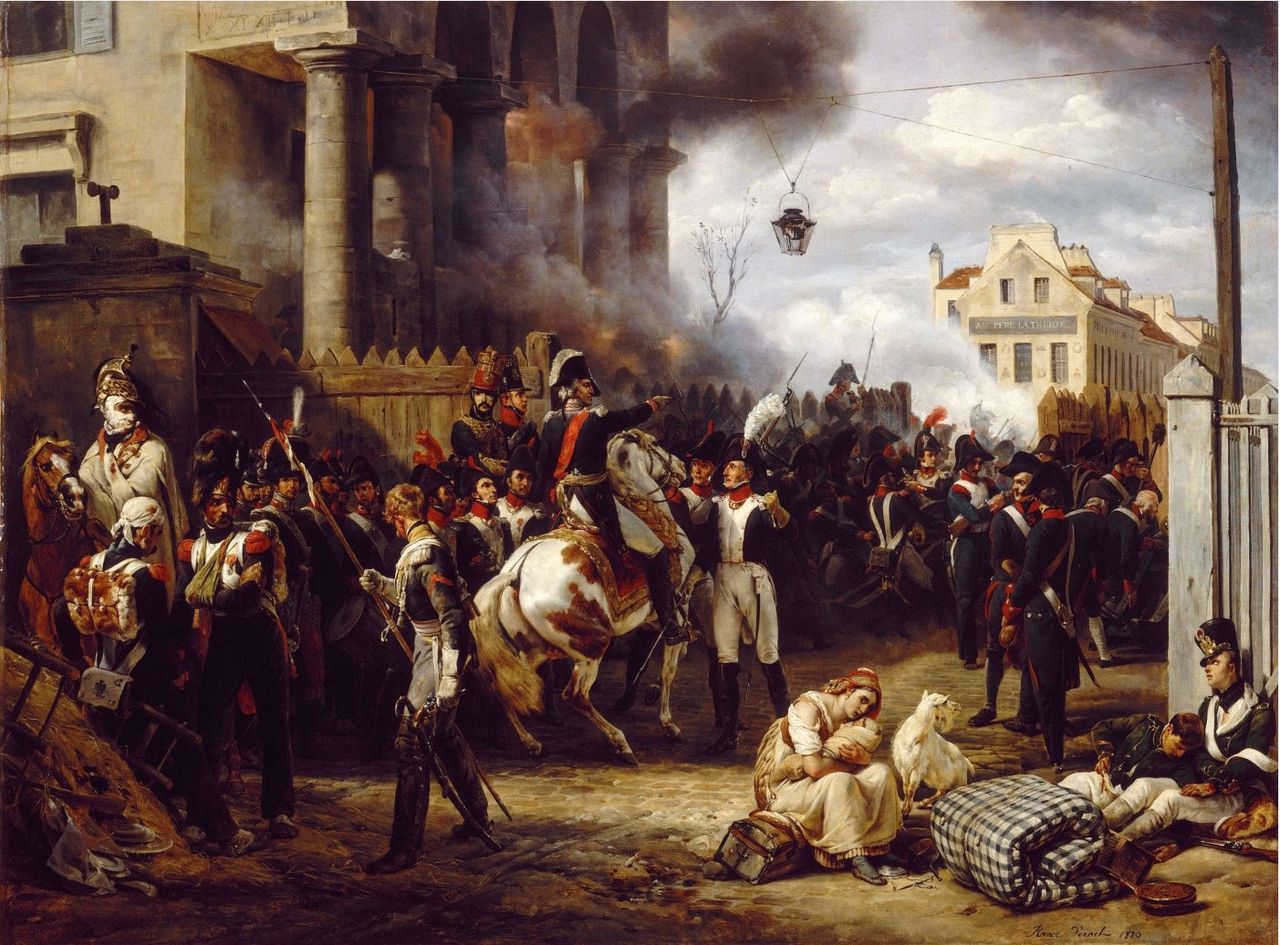
Defense of Clichy during the battle of Paris
The artist depicts the defense of Paris on the 30th of
march 1814. In the centre, marshal Moncey gives his orders to goldsmith Claude
Odiot, colonel of the national guard, for whom the painting was made.
Napoleon attempted to transform Paris into a Neoclassical capital
but also kept the city under close surveillance through his police and
officials. Paris remained a volatile focal point for radical politics
throughout the French Revolutionary and Napoleonic Wars. It surrendered to the
Allies on 31 March 1814 following the action at Montmartre, and again after
Waterloo, in June 1815.
Action at Montmartre, (30 March 1814)
The final engagement in the campaign of 1814, which led
directly to Napoleon’s first abdication. The unsuccessful defense of Paris
against the Allied armies caused the marshals to refuse to fight any longer.
During the campaign of 1814 in France, Napoleon regained his
skill at outmaneuvering the Allied armies. Although heavily outnumbered, he was
able to keep them at bay for some time. On 20 March he failed to turn back
their march on Paris at the Battle of Arcis-sur-Aube. Recognizing that his
forces were too weak to face the Allies directly, Napoleon planned to mass his
available forces and attack the Allied supply lines. As long as Paris could
hold out against the Allies, the strategy could force them to retreat. While he
marched east, Napoleon sent marshals Auguste de Marmont and Adolphe Mortier
with their weak corps to defend Paris.
Marmont and Mortier were defeated on 25 March by the Allies
at La-Fere-Champenoise and retreated directly to Paris. The marshals collected
the few men available, many of whom were veterans who were recovering from
wounds. Another 6,000 were National Guardsmen who volunteered to join the
regulars. Muskets were in short supply, and some Guardsmen were armed only with
pikes. Some civilians also joined in, but the total numbered fewer than 25,000.
Fewer than 100 guns were also available. Overall command rested upon Joseph
Bonaparte, Napoleon’s brother. In contrast, the Russian, Austrian, and Prussian
forces totaled around 110,000 men. Another 10,000 cavalry had been detached to
harass and mislead Napoleon. The Allies made their way down the river Marne and
approached Paris from the north.
The capital’s defenses had been allowed to crumble, with
Joseph comprehensively failing to restore them to an adequate state. The most
important defensive positions were natural formations, especially the knoll at
Montmartre. Recognizing this point as the key to the city’s defense, Joseph set
up his command post there on 30 March.
Fighting broke out along the entire northern side of Paris,
but the heaviest fighting was at Montmartre. Defended by Mortier’s Young Guard,
the knoll was the scene of bloody fighting. The French managed to hold their
own, with spirited counterattacks launched to recapture lost positions, but
Joseph could see that virtually the entire Allied army was present and
outnumbered the French by five or six to one. He left around noon after giving
Mortier and Marmont permission to surrender Paris if necessary.
Toward the end of the day, Marmont asked for an armistice to
negotiate a capitulation. Russian representatives were conducted to Marmont’s
house where details were hammered out, and at 2:00 A. M. a surrender agreement
was signed. The French forces marched through Paris to Fontainebleau, while the
Allies were allowed to enter. Losses for the French totaled 4,000 killed and
wounded, with another 1,000 captured. Allied losses numbered 6,700 killed and
wounded. Although the defense of Paris had been nearly hopeless, it had been
conducted with spirit.
At 11:00 A. M. on 31 March the Allied sovereigns entered
Paris, while much of the population celebrated. Prince Talleyrand, the foreign
minister, had already contacted the Russian tsar, Alexander I, organized a provisional
government, and declared Napoleon deposed as Emperor. Furious at news of the
surrender of Paris, Napoleon attempted to rally another army to continue the
war, but his marshals refused to renew the fight. Discouraged, Napoleon agreed
to abdicate, for the first time, on 6 April.
Battle of Paris 30-31 March 1814
References and further reading Delderfield, R. F.
2001. Imperial Sunset: The Fall of Napoleon, 1813-1814. Lanham, MD: Cooper
Square. Hamilton-Williams, David. 1994. The Fall of Napoleon: The Final
Betrayal. London: Brockhampton. Lawford, James. 1977. Napoleon: The Last
Campaigns, 1813-15. New York: Crown. Norman, Barbara. 1976. Napoleon and
Talleyrand: The Last Two Weeks. New York: Stein and Day. Petre, F. Loraine.
1994. Napoleon at Bay, 1814. London: Greenhill.